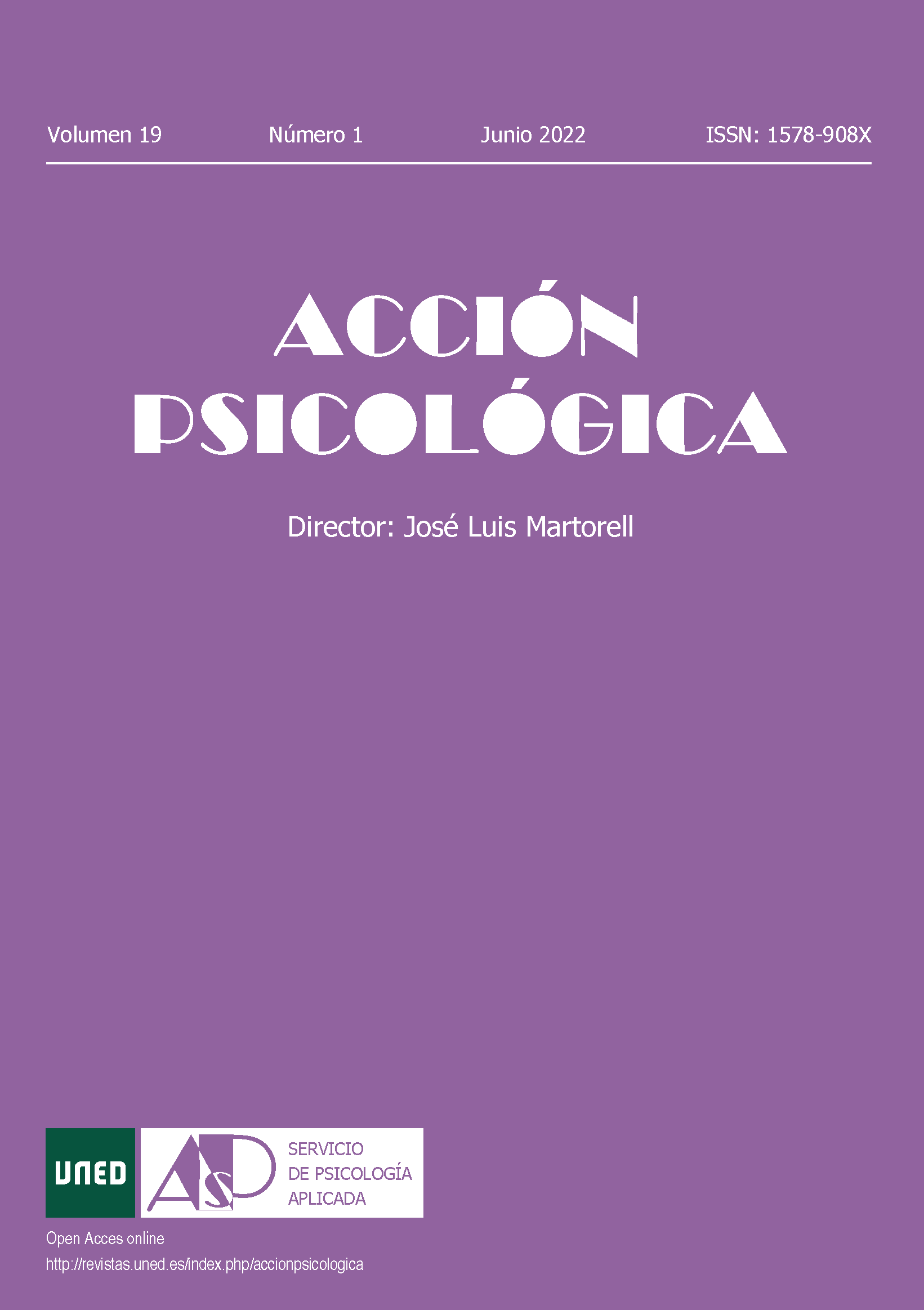The Role of Actively Open-minded Thinking among College students and its impact on future time perspectives
El papel del pensamiento activo de mente abierta entre los estudiantes universitarios y su impacto en sus perspectivas de tiempo futuro
DOI:
https://doi.org/10.5944/ap.19.1.34086Palabras clave:
pensamiento activo de mente abierta, perspectivas de tiempo futuro, estudiantes universitarios, Arabia SaudíResumen
El estudio actual tuvo como objetivo investigar el desarrollo del pensamiento de mente abierta activa (AOT) entre los estudiantes universitarios saudíes y su impacto en su perspectiva de tiempo futuro (FTP). Las muestras del estudio incluyeron 1.797 estudiantes universitarios de diferentes carreras y utilizaron el inventario AOT de (Stanovich & West, 1997) y una versión corta del inventario FTP de Zimbardo. Los resultados mostraron que no hubo desarrollo de AOT como lo ilustra la regresión lineal entre estudiantes universitarios según los subfactores de AOT. Sin embargo, los resultados de FTP demostraron que hubo un desarrollo de la experiencia actual (subfactor FTP), como lo indica la regresión lineal según la edad en la experiencia actual (subfactor FTP) aumentó con la edad. Los hallazgos revelaron una diferencia en los subfactores AOT, AOT, FTP y FTP en relación con el sexo, mostrando los hombres una puntuación más alta en comparación con las mujeres. Además, los resultados indicaron la interacción de AOT por sexo en los subfactores de FTP (es decir, presente versus futuro). Estos hallazgos indican que AOT no muestra cambios en el desarrollo según la edad entre la muestra del estudio. Por el contrario, se produjeron algunos cambios de desarrollo en los subfactores FTP y FTP según la edad.
Descargas
Citas
Adams, J. & Nettle, D. (2009). Time Perspective, Personality and Smoking, Body Mass, and Physical Activity: An Empirical Study. British Journal of health Psychology, 14(1), 83–105. https://doi.org/10.1348/135910708X299664
Baron, J. (1993). Why teaches thinking? - An Essay. Applied Psychology: an international Review, 42(3), 191–214. https://doi.org/10.1111/j.1464-0597.1993.tb00731.x
Baron, J. (1995) Myside bias in Thinking about Abortion. Thinking & Reasoning, 1(3), 221–235. https://doi.org/10.1080/13546789508256909
Baron, J. (2019). Actively Open-minded Thinking in Politics. Cognition, 188, 8–18.
Baron, J. (2008). Thinking and Deciding (4th. ed.). Cambridge University Press.
Brothers A., Chui, H., Diehl, M., & Pruchno, R. (2014). Measuring Future Time Perspective across Adulthood: Development and Evaluation of a Brief Multidimensional Questionnaire, The Gerontologist, 54(6), 1075–1088. https://doi.org/10.1093/geront/gnu076
Cate, R. A. & John, O. P. (2007). Testing Models of the Structure and Development of Future Time Perspective: Maintaining a Focus on Opportunities in Middle Age. Psychology and Aging, 22(1), 186–201. https://doi.org/10.1037/0882-7974.22.1.186
Cunningham K. F., Zhang J. W., Howell, R. T. (2015). Time Perspectives and Subjective Well-Being: A Dual-Pathway Framework. In M. Stolarski, N. Fieulaine, & V. van Beek (Eds.), Time Perspective Theory; Review, Research and Application. Springer. https://doi.org/10.1007/978-3-319-07368-2_26
Dalasio, N. (2020). Decision-making, Beliefs, and Personality: Actively Open Minds Versus Cognitive Misers. Psychology Honors Papers. https://digitalcommons.ursinus.edu/psych_hon/6
Dearing, J. A., Braimoh, A. K., Reenberg, A., Turner, B. L., & van der Leeuw, S. (2010). Complex land Systems: The Need for Long Time Perspectives to Assess their Future. Ecology and Society 15(4), Article 21. https://doi.org/10.5751/ES-03645-150421
Edgcumbe. D. R. (2021). Age Differences in Open-Mindedness: From 18 to 87-Years of Age. Experimental Aging Research, 48(1), 24-41 https://doi.org/10.1080/0361073X.2021.1923330
Haran, U., Ritov, I., & Mellers, B. A. (2013). The Role of Actively Open-Minded Thinking in Information Acquisition, Accuracy, and Calibration. Judgment and Decision Making, 8(3), 188–201. https://doi.org/10.1017/S1930297500005921
Keough, K. A., Zimbardo, P. G. & Boyd, J. N. (1999) Who's Smoking, Drinking, and Using Drugs? Time Perspective as a Predictor of Substance Use. Basic and Applied Social Psychology, 21(2), Article 149164. https://doi.org/10.1207/S15324834BA210207
Kooij, D. T. A. M., Kanfer, R., Betts, M., & Rudolph, C. W. (2018). Future Time Perspective: A Systematic Review and Meta-analysis. Journal of Applied Psychology, 103(8), 867–893. https://doi.org/10.1037/apl0000306
Ladd, J. A. (2009). The Influence of Actively Open -Minded Thinking, Incremental Theory of Intelligence, and Persuasive Messages on Mastery Goal Orientations (Doctoral Thesis). Available from ProQuest Central; ProQuest Dissertations & Theses Global.
Metz, S. E., Baelen, R. N., & Yu, A. (2020). Actively Open-minded Thinking in American Adolescents. Review of Education, 8(3), 768–799. https://doi.org/10.1002/rev3.3232
Stolarski, M., Matthews, G., Postek, S., Zimbardo, P. G., & Bitner, J. (2014). How We Feel is a Matter of Time: Relationships Between Time Perspectives and Mood. Journal of Happiness Studies, 15, 809–827. https://doi.org/10.1007/s10902-013-9450-y
Sobol-Kwapinska, M., Przepiorka, A., & Zimbardo, P. G. (2019). The Structure of Time Perspective: Age-related Differences in Poland. Time & Society, 28(1), 5–32. https://doi.org/10.1177/0961463X16656851
Stanovich, K. E. & West, R. F. (1997). Reasoning Independently of Prior Belief and Individual Differences in Actively Open-Minded Thinking. Journal of Educational Psychology, 89(2), 342–357. https://doi.org/10.1037/0022-0663.89.2.342
Stanovich, K. E. & West, R. F. (1998). Individual Differences in Rational Thought. Journal of Experimental Psychology: General, 127(2), 161–188. https://doi.org/10.1037/0096-3445.127.2.161
Stanovich, K. E. & West, R. F. (2007) Natural Myside Bias is Independent of Cognitive Ability. Thinking & Reasoning, 13(3), 225–247. https://doi.org/10.1080/13546780600780796
Svedholm-Häkkinen, A. M. & Lindeman, M. (2018) Actively Open-minded Thinking: Development of a Shortened Scale and Disentangling Attitudes Towards Knowledge and People. Thinking & Reasoning, 24(1), 21–40. https://doi.org/10.1080/13546783.2017.1378723
Toplak, M. E. & Stanovich, K. E. (2003). Associations between Myside Bias on an Informal Reasoning Task and amount of Post-secondary Education. Applied Cognitive Psychology, 17(7), 851–860. https://doi.org/10.1002/acp.915
Descargas
Publicado
Cómo citar
Número
Sección
Licencia

Esta obra está bajo una licencia internacional Creative Commons Atribución-NoComercial 4.0.











